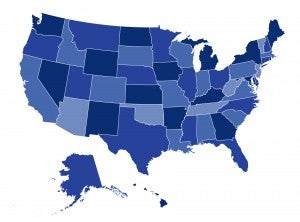
Today, the Commonwealth Fund released a new issue brief on the availability of child-only policies. The issue brief is part of an ongoing series by CHIR on implementation of the Affordable Care Act (ACA) in all 50 states and the District of Columbia.
What does the ACA do? The ACA prohibits insurers from denying or limiting coverage because of preexisting conditions. Although in effect for all individuals in 2014, the ACA banned insurers from limiting coverage because of preexisting conditions for children under the age of 19, effective September 23, 2010. In implementing this requirement, the federal government also prohibited insurers from denying coverage to children under age 19 because of preexisting conditions. In response, some insurers ceased to offer policies to children in need of an individual health insurance policy.
What did the issue brief find? To help ensure that child-only policies (individual health insurance plans made available to children under age 19 with no parent or guardian covered on the same policy) are available, states took a number of legislative and regulatory actions. Many—although not all—of these efforts were successful at encouraging insurers to make child-only policies available. Here are the findings, in brief:
- Twenty-two states and the District of Columbia passed new legislation or issued a new regulation or subregulatory guidance to promote the availability of child-only policies since January 1, 2010. Of these, nine states passed new legislation, 10 states and the District of Columbia adopted new regulatory requirements, and three states issued new subregulatory guidance.
- States adopted three approaches to promote the availability of child-only coverage:
- 9 states (Arkansas, California, Colorado, Iowa, Kentucky, New Hampshire, South Dakota, Utah, and Washington) established open enrollment periods and required insurers to offer child-only policies;
- 13 states (Delaware, Illinois, Indiana, Maryland, Missouri, Montana, Nevada, North Carolina, Ohio, Oklahoma, Oregon, Texas, and Virginia) and the District of Columbia established open enrollment periods without requiring insurers to offer child-only policies; and
- 2 (New Hampshire and Oregon) states established reinsurance pools.
- Child-only policies are available in nearly all of the states that took action to promote the availability of child-only coverage.
The issue brief also spotlights four states—Arkansas, the District of Columbia, Kentucky, and Oregon—that have been particularly innovative and successful in promoting the availability of child-only coverage. We also found that states continue to take action to promote the availability of child-only coverage, as Alaska and Georgia did in 2012.
What do the findings mean? Our findings suggest that states have a variety of options to promote the availability of child-only coverage and that engagement with insurers can lead to meaningful, innovative responses to market disruption. These findings also suggest that states should feel empowered to fill regulatory gaps in federal law, even if doing so exceeds the regulatory floor set by the ACA.
The findings also suggest that states need to implement uniform market rules that create a level playing field among insurers. States that have not yet taken action should consider whether uniform market rules or other innovative measures, such as reinsurance pools, will ensure that children have access to coverage while addressing concerns about adverse selection.
Although this brief focuses on state action regarding child-only coverage, the market disruption associated with this federal requirement presents a cautionary tale for implementation of the ACA and the broader reforms that go into effect in 2014. In particular, the findings suggest that federal regulators should work closely with state officials to address adverse selection. At the same, states have a range of tools at their disposal to help ensure that the ACA’s new requirements are meaningful for consumers and feel empowered to fill regulatory gaps in federal law.
This report follows our previous issue brief on state implementation of the early market reforms, which include new consumer protections such as dependent coverage up to age 26 and the coverage of preventive services without cost-sharing. Stay tuned for our forthcoming issue brief on state implementation of the ACA’s 2014 reforms!
To learn more about these findings and many more, I encourage you to check out the full report and news coverage on our findings. And be sure to check in with CHIRblog where we’ll keep you updated on our research and everything you need to know about the “State of the States.”

